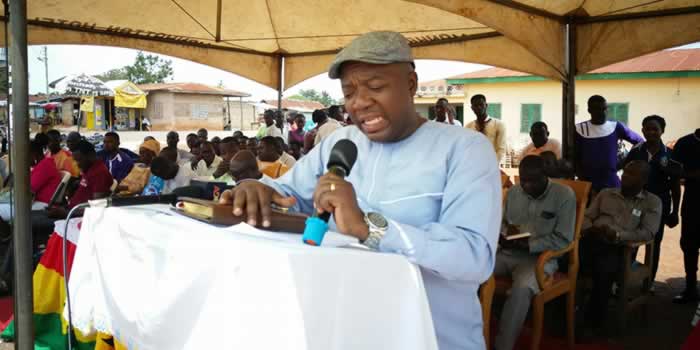

Introduction
The population size and age-sex composition of the District have broad ranging consequences for a number of socio-economic indicators and overall welfare of the people. The changes in population are mainly through fertility, mortality and migration levels, which to a large extent, are influenced by age-sex composition. The 2010 PHC was a "de facto" count of each person present in the country irrespective of nationality. The objective of this chapter is to present the information of the 2010 Population and Housing Census (PHC) results in terms of population size and distribution, age and sex structure, fertility, mortality and migration.
Population Size and Distribution
Table 2.1 presents the distribution of the population in the Sekyere Afram Plains District by age, sex and type of locality of residence. The results of the 2010 PHC show that the total population of the District is 28,535, representing about 6.0 percent of the Ashanti Region’s population. The population is made up of 15,184 males (53.2%) and 13,351 females (46.8%). In terms of the type of locality of residence, the District is entirely rural as there is no urban settlement. The population density of the District is currently 8.1 persons per square kilometre which is lower than the regional average of 196 persons per square kilometre.
Almost one-half (45.9%) of the population is aged 0-19 years. In general, there are more males than females in the District and this runs through all the age groups with the exception of the age group 20-29 and 90-99 years where females outnumber males.
Dependency ratio
Dependency ratio refers to the ratio of people in the “dependent” ages (those under 15 and ages 65 and older) to those in the “economically active ages (15-64 years). The age-dependency is often used as an indicator of the economic burden the productive portion of a population should carry - even though some people defined as “dependent” are producers and some people in the “productive” ages are economically dependent (Haupt and Kane, 2014).
Overall, the District’s dependency ratio is 95.0, indicating a high burden on the working population. This is higher than the regional average of 72.5. The high dependency ratio indicates that the economically active population and the overall economy face a greater burden to support and provide the social services needed by children and by older persons in the District.
The age dependency ratio is low for the males (91.3) than that of their female counterparts (99.4).
Sex ratio
Sex ratio is the proportion of males to females in a given population; usually it is expressed as the number of males per 100 females. The distribution of the population by sex indicates that the male population is 15,184 (53.2% of total population) and the female population is 13,351 (48.8% of total population). This gives the District overall sex ratio (i.e. number of males to 100 females) of 113.7 compared to the regional figure of 94.0. The sex ratio shows that there are more males than females in the District.
2.3 Age-Sex Structure
A population pyramid is a graphical representation of the age-sex composition of a population and its shape is influenced by the levels of fertility, mortality and migration (Ghana Statistical Service, 2013). The age structure of the Sekyere Afram Plains District is illustrated in the population pyramid in Figure 2.1.
The figure shows that the Sekyere Afram Plains District has a youthful population (Table 2.1 and Figure 2.1), as high proportion is formed by children under 15 years (46.0%) on one hand and on the other hand, there is a small proportion (2.8%) of elderly persons (65 years and older) in the District.
Fertility, Mortality and Migration
Any change in the population size (increase or decrease) is determined by fertility, mortality and migration, which are the three factors of demographic change. This section discusses fertility, mortality and migration of the District.
Fertility
Fertility is the childbearing performance of individuals or couples, measured for particular groups or populations (UNFPA, 2012). Simply, it refers to the actual child delivery i.e. frequency of childbearing among a population. Measures of fertility normally refer only to live births.
The general fertility rate (GFR) is the number of births in a given year divided by the mid-year population of women in the age groups 15-49 years. This analysis pertains to women between 15 and 49 years. Table 2.2 presents information on the fertility rate, general fertility rate and crude birth rate for the districts in Ashanti region. The table shows that there were 6,052 women 15-49 years in the Sekyere Afram Plains district with total births of 926 during the last 12 months before Census Night. This gives a Total Fertility Rate of 5.0, which is higher than the regional average of 3.3. General Fertility Rate for the District stands at 153.0 while crude birth rate is 32.5. The General Fertility Rate of the Region stands at 96 and the crude birth rate is 25.7.
Migration
A migrant is a person whose current place of residence is different from his or her place of birth or previous place of residence. There are two types of migration, namely internal and external. Internal migration is the movement of people between geographical boundaries (administrative district) within national borders whiles external migration is the movement of people across geographical boundaries outside national borders.
Internal migration can be analysed in terms of intra and inter-regional movements. Intra-regional migration refers to the movement of people between localities within an administrative region (between administrative districts within the same region), while inter-
regional migration is the movement of people between different administrative regions of the country. This is measured by information on place of birth as against place of enumeration of migrants.
Birth place of a person has been defined as the locality of usual residence of the mother at the time of birth of that individual. Table 2.5 indicates that, out of the entire population of 28,535 in the District, 12,316 are migrants representing 46.2 percent of the entire population.
Out of this, 85.3 percent was born elsewhere in another region, 11.8 percent was born in the region and 2.9 percent was born outside Ghana. For those who were born elsewhere in another region, northern regions forms the highest (5,056), followed by Upper West (2,434) and Upper East (1,244) and the least from the Central region (36).
A proportion of 10.6 percent of migrants have stayed in the District for less than a year. Less than one-third (28.5%) of them have been in the District for not more than four years but more than 1 year. The proportion of migrants who have stayed more than 20 years in the District is 12.9 percent.
Date Created : 11/23/2017 6:59:04 AM









 facebook
facebook
 twitter
twitter
 Youtube
Youtube
 +233 593 831 280
+233 593 831 280 0800 430 430
0800 430 430 GPS: GE-231-4383
GPS: GE-231-4383 info@ghanadistricts.com
info@ghanadistricts.com Box GP1044, Accra, Ghana
Box GP1044, Accra, Ghana